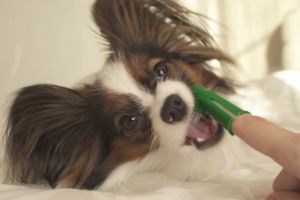It’s puppy season, people! Tiny paws that smell like Frito’s (why we’ll never know), playful behavior, soft fur, so many snuggles, and the piece de resistance - puppy breath! Let’s face it, though. As time goes on, the puppy breath typically changes to something, well, a bit more ominous. So many of us dog owners get caught up in all the other aspects of raising a puppy - including obedience training, nutrition, vaccinations, and so much more - that we forget about their teeth, gums, and mouths in general. Did you know, however, that 85 percent of pets have periodontal disease by the age of three? Whoa, right? That’s practically still a pup. We’re not here for fear-mongering but, as veterinarians, we do want to gently nudge you in the direction of good dental care for your dog from an early age.

Bad Breath, Puppies, and Dental Care - Oh My!
Bad breath isn’t an accident; our pets get it for the same reasons we do, and one of those reasons is poor oral health. However, the need for dental care goes far beyond the importance of treating “bad” teeth that are painful and, thus, can make pets reluctant to eat or drink. You can help to prevent dental disease by brushing your pet’s teeth regularly at home with a toothpaste made for pets (not humans!) and by making sure your veterinarian checks your pet's teeth at every appointment.
Out of all the members of one’s family, chances are it will not be difficult to guess who has the worst dental hygiene: the pets. It goes without saying that they don’t brush their teeth nor do they floss and this goes on for years. If you are ever curious as to what happens if teeth go for years without brushing (or you want to show your children what will become of their teeth should they fail to brush regularly), you have only to look at your pet’s teeth and smell your pet’s breath. Eek!
The Dangers of Tartar to Your Pup
In a normal mouth, the teeth are clean and white and the gums attach smoothly to the tooth. There is no redness or tartar. The tooth is bathed in saliva, bacteria, and food particles (plaque) but if this is brushed away, it never mineralizes into tartar.
If we do not regularly disinfect our dogs' mouths and brush away the plaque, the plaque will mineralize into tartar (also called calculus - gritty material that the dental hygienist scrapes away). Tartar is solid, gritty, and blocks oxygen from bathing the outer tooth, changing the nature of the bacteria that can live around the tooth. Inflammation and tenderness result in the gingival sulcus. Plaque can even destroy the attachment of the tooth and surrounding jaw bone. By the time your pup's mouth is cleaned, some or even many of their teeth might already not be able to be saved.
Worse still, the bacteria of the mouth can seed other areas int he body, leading to infection int the heart, liver, kidney, or virtually anywhere the bloodstream carries them.
In short, if regular home care is not performed on teeth, your pet’s general health and comfort will decline and expensive oral surgery and extractions will be required to get them back to normal. Gingivitis is reversible. Bone loss, once it starts, is not reversible.

What You Can Do to Foster Good Dental Health in Your Pup
It’s a good idea to become comfortable opening your pet’s mouth and looking inside. Lift the lip and look at the teeth, especially the back teeth. Open the mouth and look at the inside of the teeth and at the tongue. Many pet owners never look at their pet's teeth and are surprised at what they see when they finally do. Getting your puppy used to you looking and touching their mouth is the first step to establishing a daily home care routine.
The Importance of Veterinary Dental Care
It shouldn’t be surprising that dental health requires periodical professional cleaning regardless of whether the mouth in question belongs to a person, a dog, a cat, a horse, or some other animal. Home care of the tooth is never perfect and periodically tartar must be properly removed and the tooth surface properly polished and disinfected. We will advise you when your pet needs this cleaning done at our office but it is usually once yearly. It also depends largely on the puppy’s genes and the work you do at home.
Home Care and Products for Your Puppy’s Dental Care
Notice the shape of the canine and feline brushes and how they conform to a pet's mouth. You can use a human toothbrush but you will probably find it difficult to manipulate in the pet's mouth (although the angled ones are a little better). Never use human toothpaste for a pet as these contain sudsing agents and fluoride which are not meant to be swallowed in quantity. Animal toothpaste comes in special flavors (chicken, seafood, and malt) in addition to the more human-appreciated mint, and all are expected to be swallowed. Look for enzymatic toothpaste, as this will help break down plaque and bacterial biofilms on the tooth’s surface, preventing calculus formation.
Finger brushes are available and are smaller for puppies and kittens. I like the Oral-B children’s inserts for smaller pets.
Studies have shown that brushing three times a week was adequate to maintain healthy teeth and gums but daily brushing was needed to control existing gingivitis.
Do's and Don'ts of Brushing your Pet's Teeth
We know that brushing your puppy’s teeth isn’t the easiest task on the planet but, thankfully, there are approaches that can help.

Below are some DOs and DON’Ts when it comes to brushing your dog’s teeth:
- Don't use human toothpaste on your pet.
- Do START SLOW – It isn’t what you do today that matters but what you will be able to do for the rest of your pet’s life, so make it a pleasant daily 30-60 second routine.
- Don't attempt to clean the inner surface of your pet's teeth. Natural saliva and their larger and rougher tongues keep this surface pretty clean.
- Do try to perform dental home care at least once daily.
- Don't consider dental home care as an alternative to full dental cleaning if your pet has more advanced dental disease.
Benefits of Certain Dog Treats
For many people, doing anything inside their pet’s mouth on a regular basis is simply never going to happen. Fortunately, all is not lost: chewing on a proper dental chew daily can substantially reduce plaque and tartar by up to 69%. Chews should be used daily in order to achieve these results; occasional use is not going to be helpful and the dog must actually chew on the treat. Dental chews must be the proper size for the dog in question to avoid a choking hazard and can have sophisticated additional ingredients. Examples include ingredients to prevent mineralization of plaque (i.e. hexametaphosphate in C.E.T. Dentahex or Veggident chews) or to prevent future plaque attachment after current plaque is rubbed off (delmopinol in Oravet brand chews), and green chlorophyll (Greenies) to help with bad breath.
Dental Diets?
There is a common misconception that simply feeding a kibbled diet will protect the teeth from dental disease. Consider what it would be like to attempt to replace brushing your own teeth with eating crunchy foods and it is easy to see how ineffective this method would be. When it comes to pet foods, much of the kibble is swallowed whole and not chewed at all.
Clearly, there must be more to a dental diet than simple kibbling and in fact, there is. Dental diets on the market today use several techniques to help reduce plaque. The first is that the kibbles are very large, which means the pet must chew them before swallowing them. These diets are high in fiber, and that means the kibbles do not shatter when chewed but, instead the tooth sinks into the kibble. This allows plaque to be essentially scrubbed away. The large kibbles may pose an acceptance problem for the pet, leading the owner to use them as treats or mixed with other kibbles. The smaller the percentage of the diet these kibbles represent, the less benefit will be reaped. It is also important to realize that these diets are helpful only in cleaning the molars and premolars (i.e. the chewing teeth) and do not help the fangs or incisors, as these have minimal contact with the food. We recommend mixing Hills TD diet 1/4 to 1/3 with 2/3-3/4 of his regular kibble in the same bowl for some daily hands-off teeth maintenance.

Use Caution When Choosing Chews and Chew Toys
Use your judgment with chew toys. A chew can be readily swallowed in a large chunk and lead to intestinal obstruction but most above mentioned chews are digestible. Always look that the chew you are buying to ensure it is for your pet’s weight category. Cow hooves, antlers, and bones are not appropriate chew toys as they are too hard and readily break teeth. Pig ears are well-loved by most dogs but have been known to have bacterial contamination. Dogs with sensitive stomachs also often do not tolerate the smokey flavor. No studies have been performed regarding the prevention of dental disease using pig ear chews.
As we mentioned, we understand that it's easy to get caught up in all the cute things about your new puppy for the first few months, but don't forget to get your new furry family member into a good dental routine before plaque builds up and pain can possibly ensue. If you have any questions about how to get your pup started on a good dental regime, please give us a call!
